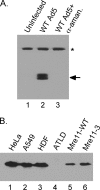Adenovirus core protein VII protects the viral genome from a DNA damage response at early times after infection
- PMID: 21345950
- PMCID: PMC3126275
- DOI: 10.1128/JVI.02540-10
Adenovirus core protein VII protects the viral genome from a DNA damage response at early times after infection
Abstract
Adenovirus has a linear, double-stranded DNA genome that is perceived by the cellular Mre11-Rad50-Nbs1 (MRN) DNA repair complex as a double-strand break. If unabated, MRN elicits a double-strand break repair response that blocks viral DNA replication and ligates the viral genomes into concatemers. There are two sets of early viral proteins that inhibit the MRN complex. The E1B-55K/E4-ORF6 complex recruits an E3 ubiquitin ligase and targets MRN proteins for proteasome-dependent degradation. The E4-ORF3 protein inhibits MRN through sequestration. The mechanism that prevents MRN recognition of the viral genome prior to the expression of these early proteins was previously unknown. Here we show a temporal correlation between the loss of viral core protein VII from the adenovirus genome and a gain of checkpoint signaling due to the double-strand break repair response. While checkpoint signaling corresponds to the recognition of the viral genome, core protein VII binding to and checkpoint signaling at viral genomes are largely mutually exclusive. Transcription is known to release protein VII from the genome, and the inhibition of transcription shows a decrease in checkpoint signaling. Finally, we show that the nuclease activity of Mre11 is dispensable for the inhibition of viral DNA replication during a DNA damage response. These results support a model involving the protection of the incoming viral genome from checkpoint signaling by core protein VII and suggest that the induction of an MRN-dependent DNA damage response may inhibit adenovirus replication by physically masking the origins of DNA replication rather than altering their integrity.
Figures







Similar articles
-
Temporal regulation of the Mre11-Rad50-Nbs1 complex during adenovirus infection.J Virol. 2009 May;83(9):4565-73. doi: 10.1128/JVI.00042-09. Epub 2009 Feb 25. J Virol. 2009. PMID: 19244322 Free PMC article.
-
Adenovirus regulates sumoylation of Mre11-Rad50-Nbs1 components through a paralog-specific mechanism.J Virol. 2012 Sep;86(18):9656-65. doi: 10.1128/JVI.01273-12. Epub 2012 Jun 27. J Virol. 2012. PMID: 22740413 Free PMC article.
-
Insight into the mechanism of inhibition of adeno-associated virus by the Mre11/Rad50/Nbs1 complex.J Virol. 2015 Jan;89(1):181-94. doi: 10.1128/JVI.01990-14. Epub 2014 Oct 15. J Virol. 2015. PMID: 25320294 Free PMC article.
-
MRN and the race to the break.Chromosoma. 2010 Apr;119(2):115-35. doi: 10.1007/s00412-009-0242-4. Epub 2009 Oct 28. Chromosoma. 2010. PMID: 19862546 Review.
-
Envisioning the dynamics and flexibility of Mre11-Rad50-Nbs1 complex to decipher its roles in DNA replication and repair.Prog Biophys Mol Biol. 2015 Mar;117(2-3):182-193. doi: 10.1016/j.pbiomolbio.2014.12.004. Epub 2015 Jan 7. Prog Biophys Mol Biol. 2015. PMID: 25576492 Free PMC article. Review.
Cited by
-
Differential activation of cellular DNA damage responses by replication-defective and replication-competent adenovirus mutants.J Virol. 2012 Dec;86(24):13324-33. doi: 10.1128/JVI.01757-12. Epub 2012 Sep 26. J Virol. 2012. PMID: 23015708 Free PMC article.
-
Cellular Zinc Finger Protein 622 Hinders Human Adenovirus Lytic Growth and Limits Binding of the Viral pVII Protein to Virus DNA.J Virol. 2019 Jan 17;93(3):e01628-18. doi: 10.1128/JVI.01628-18. Print 2019 Feb 1. J Virol. 2019. PMID: 30429337 Free PMC article.
-
E1B and E4 oncoproteins of adenovirus antagonize the effect of apoptosis inducing factor.Virology. 2014 May;456-457:205-19. doi: 10.1016/j.virol.2014.03.010. Epub 2014 Apr 15. Virology. 2014. PMID: 24889240 Free PMC article.
-
Understanding Post Entry Sorting of Adenovirus Capsids; A Chance to Change Vaccine Vector Properties.Viruses. 2021 Jun 24;13(7):1221. doi: 10.3390/v13071221. Viruses. 2021. PMID: 34202573 Free PMC article. Review.
-
Tip60 degradation by adenovirus relieves transcriptional repression of viral transcriptional activator EIA.Oncogene. 2013 Oct 17;32(42):5017-25. doi: 10.1038/onc.2012.534. Epub 2012 Nov 26. Oncogene. 2013. PMID: 23178490 Free PMC article.
References
-
- Bakkenist C. J., Kastan M. B. 2003. DNA damage activates ATM through intermolecular autophosphorylation and dimer dissociation. Nature 421:499–506 - PubMed
-
- Burma S., Chen B. P., Murphy M., Kurimasa A., Chen D. J. 2001. ATM phosphorylates histone H2AX in response to DNA double-strand breaks. J. Biol. Chem. 276:42462–42467 - PubMed
Publication types
MeSH terms
Substances
Grants and funding
LinkOut - more resources
Full Text Sources
Other Literature Sources
Research Materials
Miscellaneous

